Q&A – Ask Neil: May 4, 2023
(Please read these instructions carefully.)
Before you post your question, please look at recent issues to see if someone else has already asked it. You might find your answer there.
How to submit your question…
• Click the link provided below to post your question. After you submit your question, a new window will pop up giving you the address to which you can e-mail a sharp, high-resolution photo to accompany your question. Please do not send thumbnail photos in case I need to zoom in to see things.
• Click here to post your question.
• Please only post your question one time. We can only accept a set number of questions each week, and when we get duplicates it costs other people their chances.
• One question per reader, please.
• Please use this only for posting questions – not for standard emails.
• Watch for your answer in the following week’s e-gardens.
• I choose those of greatest general interest. For example, plant IDs seldom make the cut.
• I must have your first name or initials.
• I must have your city or county. (Texas is a very large state.)
QUESTION 1
WHAT’S WRONG WITH OUR LIVE OAK? CAN IT BE SAVED?
Question: Our live oak didn’t look good after the freeze of February 2021. I had a tree service trim it back in February 2022. It was covered with large black ants. This year it sent out plumes, but no leaves and I noticed the loose bark. Am I going to lose it? Tommy B., Coppell.
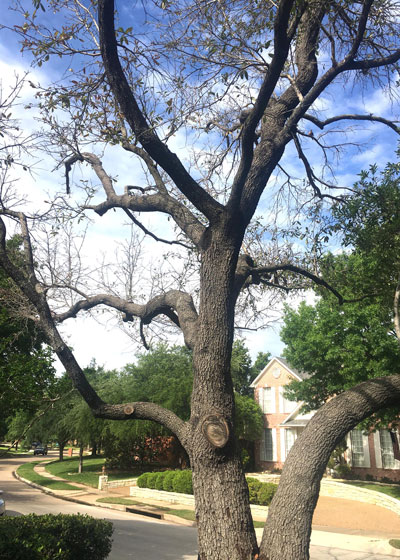
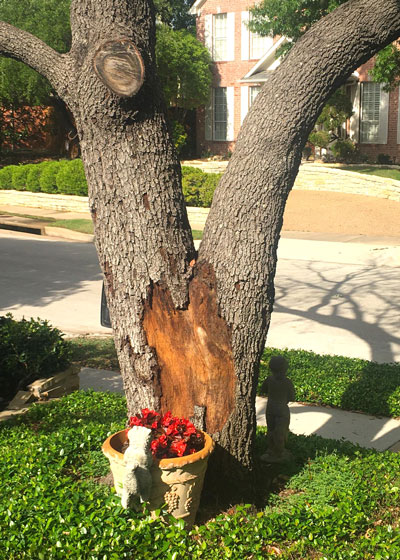
Answer: It doesn’t look good for your live oak. This is the radial shake damage as identified soon after that cold spell by the Texas A&M Forest Service. Some trees lost bark within weeks. Others are still losing bark. The more bark is lost the thinner the top growth becomes until the tree is completely bare and dead. It’s time to have it removed before it falls and does damage. Crazy as it sounds, another live oak would still be one of the best options. Oh, yes. The ants were in no way responsible. They were just “hanging out” on your tree.
QUESTION 2
WHY HASN’T MY WISTERIA BLOOMED?
Question: This is the fourth year that I’ve had my wisteria that I bought at a local nursery. I’ve only had one bloom in all that time. What could be going wrong? Carolyn F., Fairfield.
Answer: Begging indulgence, I’m going to utilize the answer from my website’s 1001 FAQs.
“This is the most-asked question pertaining to vines. To say the least, it’s a common problem. Often the exact cause will be hard to determine. Factors include shade (wisterias need full sun for best flowering), excessive nitrogen (nitrogen promotes vegetative growth at the expense of flower bud production) and pruning at the wrong time (any major pruning of wisterias should be done immediately after the blooming season).”
Sometimes the factors stir together and are hard to separate out. It might be a mix of two or all three of those. Hope this helps.
QUESTION 3
HOW CAN I ELIMINATE LIRIOPE IN MY LAWN?
Question: This weed has been identified as liriope in my lawn. I suspect it has been transplanted in accidentally by landscapers. How can I eliminate it? Ed G., Dallas.
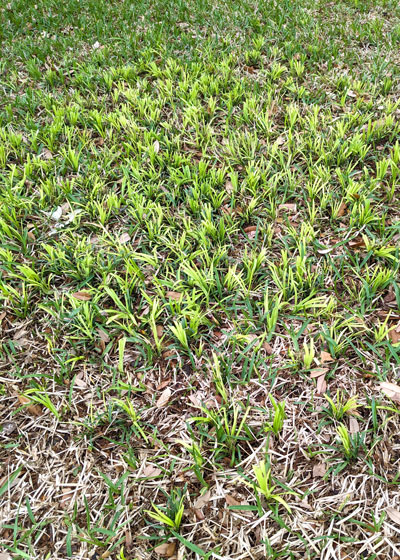
Answer: It does look like it could be liriope, but it could also be nutsedge. Dig a few plants up and look at their roots closely. They will be your best clues. A broadleafed weedkiller spray applied in a fine droplet size and with one drop of liquid dishwashing detergent per gallon of mixed spray would eliminate liriope. Two or three sprayings might be needed. The original Image intended for nutsedge or Sedgehammer would get rid of nutsedge.
QUESTION 4
WHY ARE LEAVES OF BUR OAK SEEDLINGS TURNING BROWN?
Question: Last fall I collected bur oak acorns. I soaked them in water for a day, wrapped them in a paper towel and placed them in a zip-locking bag in the refrigerator over the winter. In late February this year I planted them in a trench that was 4 inches wide by 18 inches long and 10 inches deep. I gave them ¼-cup of 20-0-4 fertilizer. Why are they brown/bronze? Douglas G., Salado.

Answer: You certainly went to a lot of work. I normally just plant mine as soon as I harvest them, and I plant them directly into pots so they’ll never know they’ve been transplanted. That seems like a great deal of fertilizer for such a small volume of soil. That’s the thing that really sticks out in my mind. I would keep them watered very thoroughly during dry periods. See if the leaves don’t develop a more normal color.
QUESTION 5
WHY ARE TIPS OF ELM TWIGS DROPPING?
Question: What could be attacking my elms? They’re dropping healthy leaves from the tips of the branches. One is dead. One is hurting. One is declining. Carla S., Azle, Parker County.
Answer: Oh, for a photo and the specifics of what type of elm, but I’ll proceed with what information I do have. Elms do drop leaves rather freely in the spring, often helped by birds and squirrels. However, that won’t happen to the point of losing all of their leaves and dying. That sounds more like cotton root rot with lacebark elms. It’s a soil-borne fungus that will move down a row of susceptible plants through root sharing and contaminated soil. But all of that is speculation without knowing for sure “who the patient is.”
QUESTION 6
WHAT IS WRONG WITH MY BLUE POINT JUNIPER?
Question: I believe this is a Blue Point juniper that is 9 years old. This spring it has developed this discoloration. Should I prune out the dying branches? What can be done? Laurene R., Dallas.
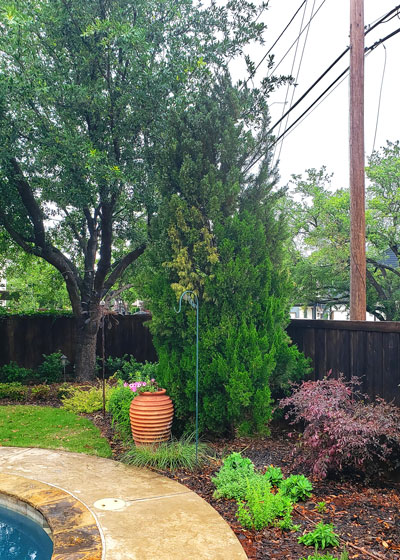
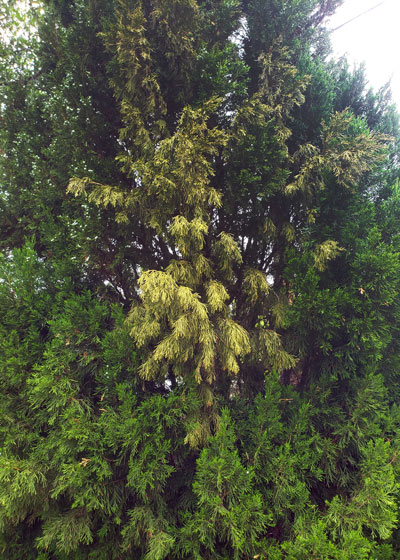
Answer: I’m not sure what juniper you have, but I don’t believe it’s Blue Point. It looks more like my old Spartan junipers. However, the diseases that attack one attack the other, so it doesn’t really matter. There are several tip and twig blights that ravage upright junipers, notably those two cultivars in my experiences. Landscape contractors may have seen them on others. They are caused by the funguses Phomopsis and Kabatina. I would suggest that you Google those two names, including also “university” and “Juniperus” as key words in your search to get you into the serious discussions of the problems. All the reading I have done has said that you can prune out the dead wood if you do so immediately, but I’ve also noticed that it quickly disfigures the plants. Unfortunately, there are no sprays that effectively slow or stop the spread of these two tenacious diseases. I’m sorry. (In answer to the unasked question: You might switch over to Oakland or Nellie R. Stevens hollies. Both are tall upright screens. Oakland tends to be tighter, more formal and slower growing.)
QUESTION 7
WHAT IS WRONG WITH MY BIG TOOTH MAPLE?
Question: I have two big tooth maples. As you can tell from my photos, one leafed out normally while the other only has leaves on its east side. What should I do? Mark M., Bexar Co.
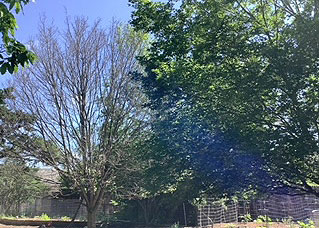

Answer: Best I can tell, neither tree is thriving. I can’t see any details at all of what might have caused the problems. The photos came through as tiny thumbnails. Check the trunks for signs of small borer holes (size of a pencil lead). Have you applied any kind of weed-and-feed fertilizer near them? I’d suggest you go to a local independent retail garden center during the week (when they’re not so busy) and talk to a Texas Certified Nursery Professional. Take high-resolution photographs printed on photo paper. Take samples of any problems you can carry in. Have dates of when the problems starting showing up. Show records of anything that might have happened near the trees. These are the sorts of things I needed to have.
